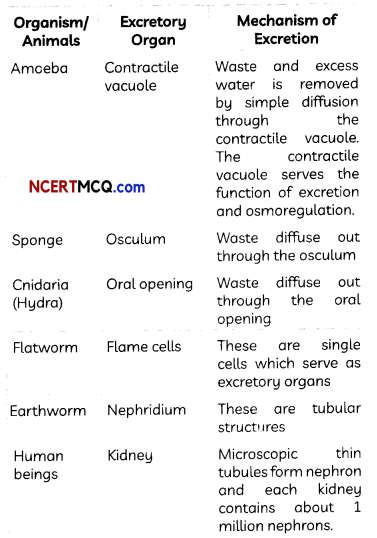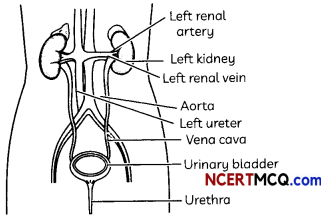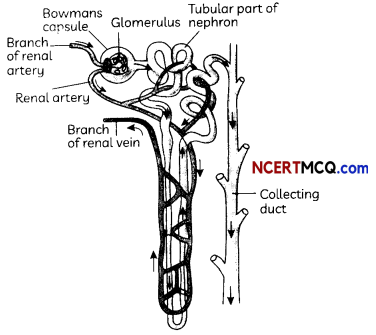Excretion
The biological process of removal of excess or toxic wastes from the body is called excretion. Many unicellular organisms remove these wastes by simple diffusion from the body surface into the surrounding water.
Osmoregulation: The process of maintaining the right amount of water and proper ionic balance in the body is called osmoregulation.
Excretion in Animals
A summary of excretory organs in some animals is given as follows:

Excretion in Human Beings
The excretory system of human beings includes:
1. A pair of bean-shaped kidneys: Kidneys are located in the abdomen, one on either side of the backbone. Urine produced in the kidneys passes through the ureters into the urinary bladder where it is stored until it is released through the urethra.

2. Each kidney has large numbers of these filtration units called nephrons packed close together. The structure of the nephron is described below:
3. Bowman’s capsule: It is a double-walled cup-shaped structure present at the upper end of the nephron.
4. Glomerulus: These are a bundle of blood capillaries present in the Bowman’s capsule. One end of the glomerulus is attached to the renal artery (it brings dirty blood containing wastes into the kidney) and the other end is attached to the renal vein (it carries away the clean blood from the kidney). The function of the glomerulus is to filter the blood passing through it.
5. Tubule: It consists of the proximal convoluted tubule, Henle’s loop, and distal convoluted tubule. The function of tubule is reabsorption of useful substances such as glucose and amino acids into the blood capillaries.

![]()
Formation of Urine
The purpose of making urine is to filter out waste products from the blood. Nitrogenous waste such as urea or uric acid are removed from blood in the kidneys.
- The waste material is brought to the kidneys by the renal arteries.
- Blood is filtered from the blood capillaries into Bowman’s capsule.
- The filtrate passes into the tubule.
- Re-absorption of useful substances such as glucose, amino acids, salts and a major amount of water into the blood capillaries takes place.
- The amount of water reabsorbed depends on how much excess water there is in the body, and on how much of dissolved waste there is to be excreted.
- The urine formed in each kidney eventually enters a long tube, the ureter, which connects the kidneys with the urinary bladder.
- Urine containing water and nitrogenous substances passes into the urinary bladder where it is stored till it is thrown out of the body.
- We can usually control the urge to urinate as the urinary bladder is muscular and under nervous control.
The urine formation involves three steps :
- Glomerular filtration: Nitrogenous wastes, glucose water, amino acid filter from the blood into Bowman Capsule of the nephron.
- Tubular reabsorption: Now, useful substances from the filtrate are reabsorbed back by capillaries surrounding the nephron.
- Secretion: Urea, extra water and salts are secreted into the tubule which open up into the collecting duct and then into the ureter.
Role of Kidney
Kidneys not only function to remove toxic waste, but also control water balance and levels of mineral ions in the body. Freshwater animals take up large amount of water through their skin and mouth. They need to get rid of it by frequent excretion of lot of urine. Marine animals and terrestrial animals, including humans, need to conserve water. For this, the excretory system is able to reabsorb water. Such reabsorption or removal of excessive water is under hormonaL control.
Renal failure:
The failure of the kidney due to a kidney infection or injury to kidneys or restricted blood flow to the kidneys due to which the kidney is unable to clean the blood of metabolic wastes and to maintain normal levels of water and mineral ions in body fluids is known as renal failure.
![]()
Dialysis:
The procedure used in the artificial kidneys in place of normal is known as dialysis which is carried out during renal failure.
Principle of dialysis:
Blood is made to flow into the dialysis machine made of long cellulose tubes coiled in a tank having a dialyzing solution. Waste substances diffuse out of bLood into the tank and the clean blood is pumped back into the patient.
Artificial kidney (Fiamodialysis):
An artificial kidney is a device to remove nitrogenous waste products from the blood through dialysis. Artificial kidneys contain a number of tubes with a semi-permeable lining, suspended in a tank filled with dialyzing fluid. This fluid has the same osmotic pressure as blood, except that it is devoid of nitrogenous wastes. The patient’s blood is passed through these tubes. During this passage, the waste products from the blood pass into a dialyzing fluid by diffusion. The purified blood is pumped back into the patient. This is similar to the function of the kidney, but it is different since there is no reabsorption involved. Normally, in a healthy adult, the initial filtrate in the kidneys is about 180 L daily. However, the volume actually excreted is only a litre or two a day, because the remaining filtrate is reabsorbed in the kidney tubules.
Example 1.
Compare the functioning of alveoli in the lungs and nephrons in the kidneys with respect to their structure and functioning.
Answer:
Comparison between the functioning of alveoli and nephron
| Alveoli | Nephron |
| 1. Alveoli are balloon-like structures with thin walls and fine surfaces. | 1. Nephrons are cup-shaped structures having thin walls, attached to a thin-walled tubule |
| 2. The walls of the alveoli contain an extensive network of blood capillaries for the exchange of gases. | 2. Bowman’s capsule is supplied with a cluster of capillaries, called glomerulus for filtration. A network of blood vessels is present around the tubular part of the nephron for the reabsorption of useful products and water. |
| 3. Alveoli increases surface area for diffusion of carbon dioxide from the blood to air and oxygen from air to blood | 3. Nephrons also increase the surface area for filtration of blood and reabsorption of useful products and water from filtrate leaving behind urine. |
| 4. Alveoli only provide a surface for the exchange of gases in the lungs. | 4. Tubular part of the nephron also carries the urine to the collecting duct. |
| 5. Alveoli are very small and a large number of them are present in each lung. | 5. Nephrons, as basic filtration units, are packed close together and are present in large numbers, in each kidney. |
Excretion in Plants:
- Oxygen and carbon dioxide are the waste products generated in plants during photosynthesis. The plants get rid of these gaseous waste products through stomata in leaves and lenticels in stems.
- They can get rid of excess water by transpiration.
- Many pLant waste products are stored in cellular vacuoles.
- Plants get rid of stored solid and liquid wastes by shedding of leaves, peeling of bark and felling of fruits.
- Other waste products are stored as resins and gums, especially in old xylem.
- Plants also excrete some waste substances into the soil around them.